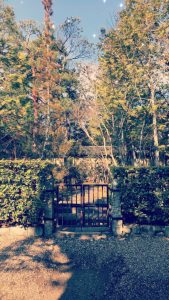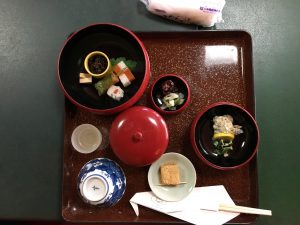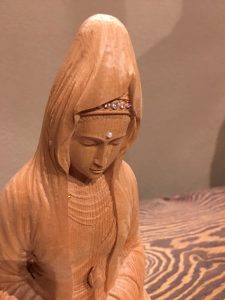
Garden found in Daitokuji
Today we attended a lecture by Catherine Ludvik on Zen Temples. It was a refreshing reintroduction, as to be honest I started to become tired of the Temples, since I wasn’t quite sure what I was looking at. We learnt about the water symbolism found in the Sanmon gate, to ward off the possibility of burning down. I was slightly perplexed by the use of wooden gates that were susceptabile to fire, but understandable be so as any other material would detract from its beauty. I wonder if they do, or if not how opposed the Abbot would be in using modern preservation methods such as a fire-resistant intumescent coating, or using woods that don’t burn as easily. There were other interesting snippets of information, such as the story surrounding the statue of Sen No Rikyu. In 1529 the Daitokuji was erected, and underwent restoration in 1589. The restoration was supported financially by Sen No Rikyu, and in turn he had a statue of himself erected at the temple. When Hideyoshi walked through the temple and under the feet of the Sen No Rikyu statue, Hideyoshi became enraged as symbolically he had walked under the feet of someone below him. Hideyoshi ordered Sen No Rikyu to apologise, and when he refused, to commit seppoku in 1591. The statue was then removed, and crucified – both the heads of the statue and Sen No Rikyu were cut clean off.
The part I found most interesting was learning about Yuki Murabayashi and her role as an artist in residence. She was choosen out of 30 applicants to oversee the screen painting of the Taizo-in’s main hall. The original screens were painted by Kano Ryokei, but have since then been made a national treasure, and whisked away for restoration and preservation. The new screen printings were to be created in conjunction with contemporary times, as opposed to recycling any previous concepts. It was also required that a young unknown artist should be supported. Graduate student Yuki Murabayashi fit the bill, and was thus choosen. While cliche, in many ways I felt I could relate to Yuki’s TEDx Talk, when she reflects on her art style and how it grew over the years. Similiar to Yuki as I child I would draw alot of female anime characters, and did so after watching lots of TV animation! As I got older I started drawing more from life models, no longer “editing” with the goal of producing an end productive, but being more contemplative about those that surround me and the emotions in their faces. Now I use lines to better understand the movement and direction others are undergoing.

One Squishy Brown Boi
After the lecture we had an interesting lunch. To be honest I wasn’t quite sure what to expect, and I wasn’t that excited for it. However I really enjoyed some parts of the meal, particularly the 1st drink and the warabimochi. It was also great to practice by very bad chopstick skilks. It was a 7 bowl meal, with some parts being presented at the beginings, and others brought in after.
After the meal we walked around for a bit, before meeting with Gakyu Miyamoto. I enjoyed his whimsical daruma sculptures, and so it was great to meet the face behind the work. You could sense the passion and dedication he had to his work, something you don’t get when you evaluate someones work from behind a screen, or bustling along a musuem corridor or store front. With the artist there you could connect better to the source of his creation, and view his work as an extension of himself. He puts alot of care and thought into his pieces, even the simplest aspects you would think are solely aesthetic choices, each have a meaning special to him. He also spoke of some of the technical sides to being an artist, such as sourcing the cyprus he uses for his carvings. The cyprus is taken from the Kiso region, as the temperature there is constant year round, leading to equally spaced concentric circles that

Engagement Sculpture
when carved provide a smoother tactile texture and interesting visual texture that blend into the carvings. Gakyu also spoke of balancing the creative freedom with his other themes expressed in his work, versus working on temple commissioned pieces. Most importantly, the carvings of Buddha are not considered art, or atleast “maybe” one can consider them art while they are a work in progress, but upon completetion and given their soul they are a religious artefact. Another interesting aspect of the attribution of a soul is when a buddha sculpture is being restored, it must have its soul removed, or ones chisel could hurt the buddha. Lastly, one of his interesting pieces was an engagement sculpture for his wife. I thought it was quite beautiful (as well as smart!) and included a photo here.

